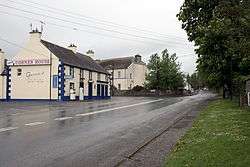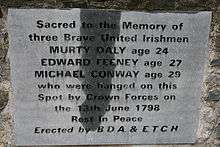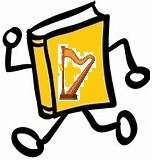Ballycumber
Ballycumber (Irish: Béal Átha Chomair, meaning "ford-mouth of (the) confluence")[2] is a village located where the R436 regional road crosses the River Brosna in County Offaly, Ireland. It is 5 km (3.1 mi) west of the town of Clara, on the western edge of Clara bog. According to the 2016 census, the population of Ballycumber was 208 people.[1]
Ballycumber Béal Átha Chomair | |
|---|---|
Village | |
 Ballycumber | |
 Ballycumber Location in Ireland | |
| Coordinates: 53.326509°N 7.6854524°W | |
| Country | Ireland |
| Province | Leinster |
| County | Offaly |
| Population (2016)[1] | 208 |
| Time zone | UTC+0 (WET) |
| • Summer (DST) | UTC-1 (IST (WEST)) |
Ballycumber is located in the civil parish of Leamonaghan. The church in nearby Boher (dedicated to Saint Manchán of Lemanaghan, a local saint) was opened in 1861; before that there was a mud-walled church in the area which has left no trace.
Transport

The M6 motorway connecting Dublin and Galway is a ten-minute drive away. Bus Éireann runs an hourly schedule from Moate and Tullamore with buses going to Galway, Dublin, Waterford, and Belfast. Iarnód Éireann run a train from Dublin to Galway every half-hour from Clara train station. Ballycumber station opened on 1 March 1862 and closed on 17 June 1963.[3]
Education
Boher National School is located beside Saint Manchan's Church in Boher, outside Ballycumber. It was reputedly founded by Saint Manchan and Saint Ciaran, hence its name. As of 2017, the school had more than about 120 pupils.[4] The old schoolhouse, to the west of the church, was turned into living quarters as the new school was built to the east of the church in 1989.
Sports
Ballycumber GAA pitch is located 2 miles (3.2 km) outside of the village with an adjoining community centre. Ballycumber have many titles to their name. Their colours are blue and saffron. There is a senior team, consisting of just Ballycumber players. However, the minor, Under-21, U-16, U-14, U-10 and U-8's team are joined with Tubber GAA to form Ballycumber/Tubber.
Brosna Gaels is the local hurling team, made up of the parish of Leamonaghan, which includes Ballycumber, Doon and Pullough with permission players from Tubber. Brosna Gaels field teams at all levels from Senior to Under-6. They gained senior status following a 2009 Intermediate Championship win.
Ballycumber also have an association football team, Ballycumber Rovers, which has won county cups and other titles.
Ballycumber in literature
The name of Ballycumber is defined in a jocular manner by writer Douglas Adams in The Meaning of Liff, as "BALLYCUMBER: (n) One of the six half-read books lying somewhere in your bed."[5].
The mascot / symbol of BookCrossing was named after this phenomenon, it consists of a little yellow running book. Travelling books which are registered on Bookcrossing.com prominently display Ballycumber labels, currently (2017) over 11.7 million books travelling through 132 countries. Thus the name and symbol of Ballycumber has become an ambassador for literacy and random acts of kindness.

The play "Tales of Ballycumber" by Sebastian Barry was shown in Abbey Theatre in Dublin in 2009.[6]
References
- "Sapmap Area - Settlements - Ballycumber". Census 2016. Central Statistics Office. April 2016. Retrieved 20 February 2020.
- Béal Átha Chomair Placenames Database of Ireland. Retrieved: 2014-04-24.
- "Ballycumber station" (PDF). Railscot - Irish Railways. Archived (PDF) from the original on 26 September 2007. Retrieved 10 September 2007.
- "Department of Education and Skills - Whole School Evaluation Report - St Ciaran's Mixed N S" (PDF). education.ie. Department of Education. 22 March 2017. Retrieved 21 February 2020.
- "Bookcrossing FAQs". Bookcrossing.com.
- "Tales of Ballycumber". Abbey Theatre. Archived from the original on 6 February 2014. Retrieved 13 February 2012.